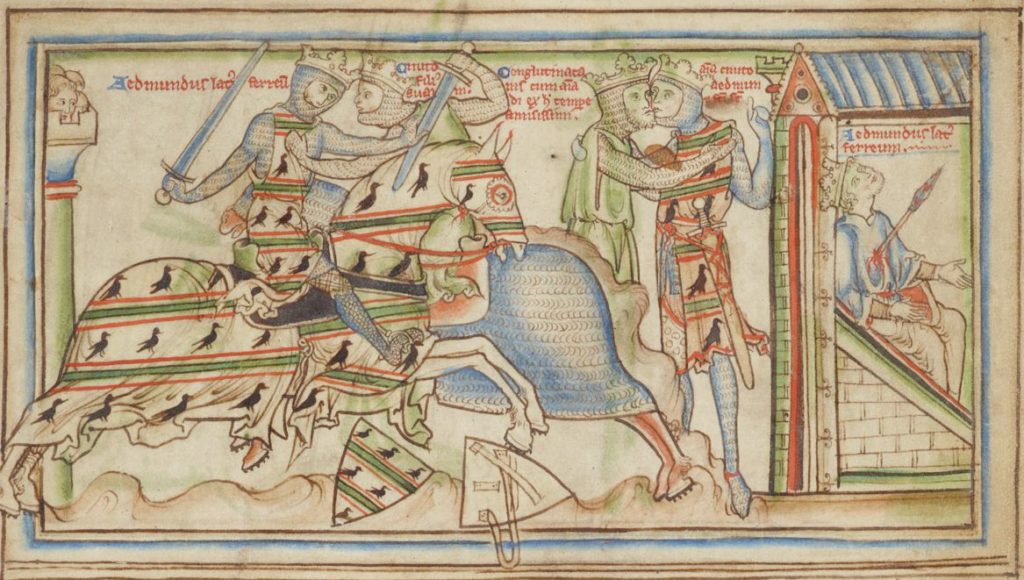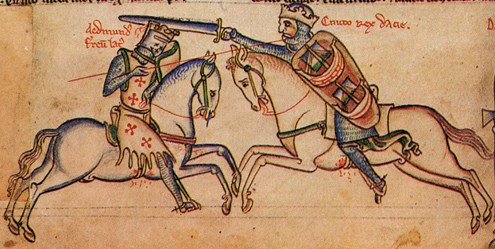
In the year 1016, the succession was bitterly contested between Edmund Ironside and Canute (or Knut) the Dane. Although Wessex had submitted to Canute late in 1015, Aethelred was still alive and sulking in London, leaving his son Edmund to fight his battles. But this didn’t last long; King Aethelred took his last breath on 23 April 1016, and London declared Edmund king. Now England had two kings, and so began a treacherous struggle marked by five major battles, men changing sides, a siege of London where Canute was said to have dug a trench around the city, and many, many dead warriors.
Although Edmund stoutly aided London in its defense against the Danes, he frequently left the city in order to draw the Danes away from their siege. It is said he raised five armies that year–one for each battle. The last and most important, the Battle of Assandun took place on October 18, ended in disaster for the Saxons because of the treachery of Eadric Streona, who took to flight with his forces and turned the tide against Edmund.
This time Canute was determined to end the conflicts. The Saxons withdrew but the Danes followed them up the Severn river into Gloucestershire, finally stopping at an island called Olney (or Alney). There, in deference to the chieftains of the land who had had enough (led by Eadric Streona, who somehow retained the goodwill of Edmund Ironside), the two Kings decided to solve the issue by single combat. This legend comes down to us through the chroniclers, as unlikely as it sounds.

The Saxon King was said to have been the stronger fighter and soon hammered the Dane, breaking his shield and beating him down when Canute called a stop to the fight. “Bravest of youths,” he cried out, “why should either of us risk his life for the sake of a crown?” Edmund paused, considering. “Let us be brothers by adoption,” the Dane continued, “and divide the kingdom, governing so that I may rule your affairs, and you mine.” (Florence of Worcester).
The single combat story is probably apocryphal, but the ensuing treaty is not. According to their agreement, Canute was to rule Northumbria and Danish Mercia, while Edmund was ruler of Wessex, Essex, East Anglia, and English Mercia. It’s unclear who was supposed to rule London (I found it stated both ways), but in the end, the Londoners were obliged to come up with their own tribute payment to Canute and permit him to anchor his ships in the Thames for winter, so I guess the result speaks for itself.
Most importantly, it was stated that this treaty excluded brothers and children of the two Kings; if either was to die, all the possessions would revert to the other. And so when Edmund Ironside died suddenly in the winter of 1016, Canute took the crown and made sure to bring the witnesses forward to confirm the terms of the treaty. An exhausted England accepted his claim without demurring.
You can read about this and more in my novel, GODWINE KINGMAKER. Of course, I assume Godwine was witness to these great events!
Karen says:
Yet another sudden death. But it is winter this time at least, and nothing about feasts and convulsions. So maybe he died of natural causes in the cold winter.
Mercedes Rochelle says:
I’ve read that Edmund may have died from his wounds taken at the battle of Assundun. I’m inclined to this story. I don’t really give much credence to the sword up the nether region theory… who would bother to climb into a cesspit?